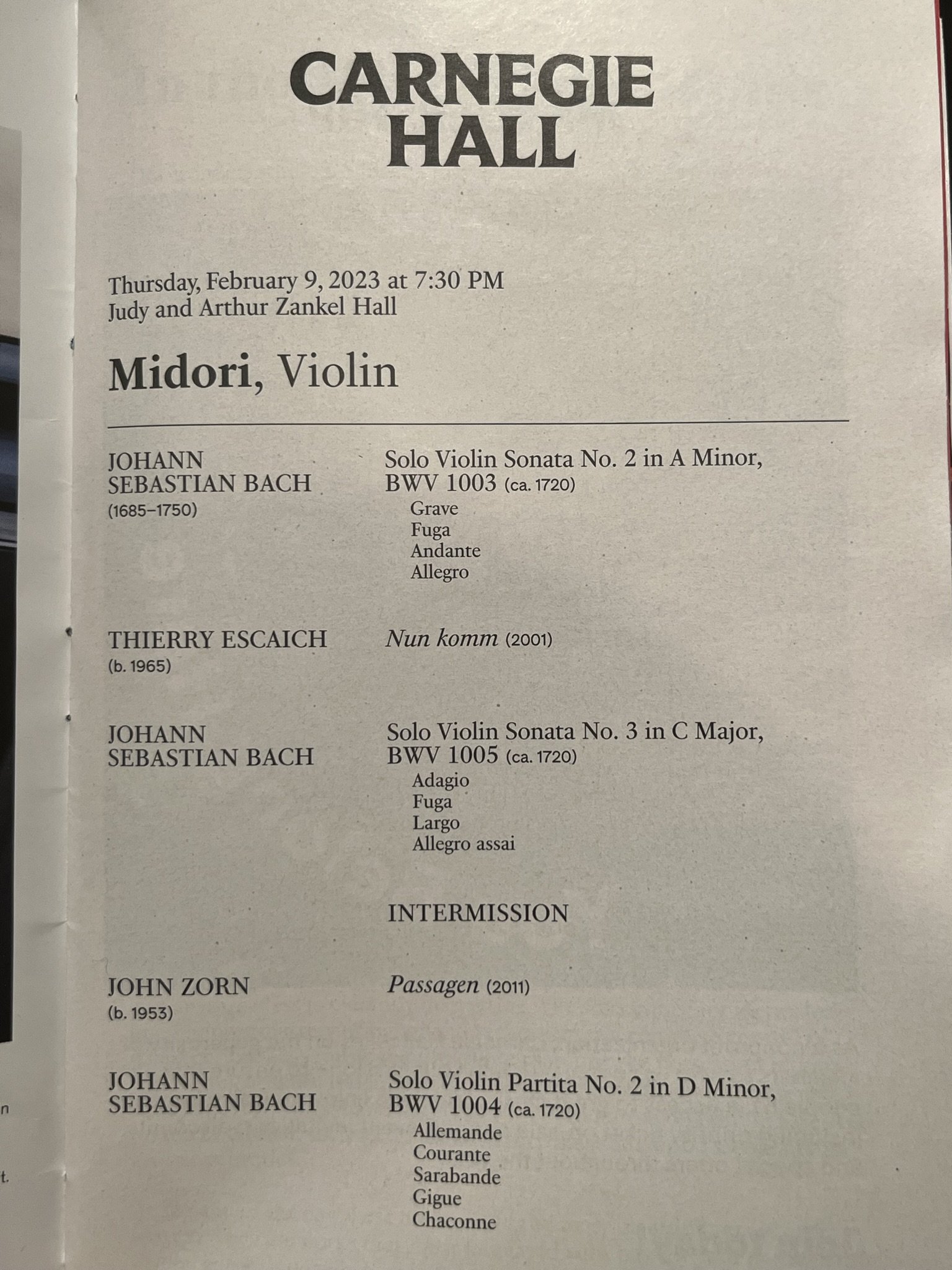Bach, Sonata and Partita
https://open.qobuz.com/album/8800404123280
Midori is a visionary artist, activist, and educator who explores and builds connections between music and the human experience while breaking with traditional boundaries.
Program note
https://www.carnegiehall.org/Calendar/2023/02/09/Midori-Violin-0730PM
JOHANN SEBASTIAN BACH
Solo Violin Sonata No. 2 in A Minor, BWV 1003
I. Grave
II. Fuga
III. Andante
IV. Allegro
Breathtaking contrapuntal and harmonic complexity by means of a single melodic instrument.
Although a number of composers had written music for solo violin in the 17th century, none was on the scale that Bach attempted. Nor had anyone achieved such breathtaking contrapuntal and harmonic complexity by means of a single melodic instrument.So combined in a single part all the notes required to make the modulations complete that a second part is neither necessary nor desirable.
An open-sounding cadence on a unison E ushers in one of Bach’s longest (286 bars) and most elaborate fugues. A densely woven tapestry of short rhythmic and melodic motifs, the music shifts restlessly from one tonal center to another, alternating between brilliant intensity and quiet reflection, finally coming to rest on a resounding A-major chord. A sharp contrast is in store in the Andante, a luminous aria that gently ebbs and flows above a steady current of pulsing eighth notes. Each of the movement’s two parts is repeated, inviting the performer to embellish Bach’s rather austere melodic line. Then comes another surprise: a burst of pent-up energy in racing 16th notes, each of the opening phrases followed by an echo, and each half of the movement played twice. The tension and momentum build inexorably until the Allegro reaches its exhilarating climax.
THIERRY ESCAICH
Nun komm
http://www.escaich.org/en/
https://www.youtube.com/watch?v=S2PqWSfo-9w
Nun komm, composed in 2001 for violinist David Grimal, is a short, phantasmagorical rumination on the Lutheran chorale “Nun komm, der Heiden Heiland” (“Savior of the Nations, Come”).
Escaich’s violin solo calls for an array of extended instrumental techniques, as well as updated versions of some of the compositional techniques that Bach used in his mighty D-Minor Chaconne, to be heard at the end of tonight’s concert.
2001年にバイオリニストのデビッド・グリマルのために作曲されたNun kommは、ルター派の合唱曲「Nun komm, der Heiden Heiland」(「諸国民の救世主よ、来てください」)の短い幻想的な反芻です。
エスカイクのヴァイオリン ソロは、卓越した名手であり、バッハが強力なニ短調シャコンヌで使用したいくつかの作曲テクニックの更新版だけでなく、一連の拡張された楽器テクニックを必要とし、今夜のコンサートの最後に聞くことができます。
JOHANN SEBASTIAN BACH
Solo Violin Sonata No. 3 in C Major, BWV 1005
I. Adagio
II. Fuga: Allabreve
III. Largo
IV. Allegro assai
The opening Adagio features a quietly insistent thematic motive—a repeated oscillating figure in dotted rhythm that wanders imperturbably from register to register, its stately progress interrupted by an occasional flourish. Once again, Bach starts the Fuga on the dominant (the fifth degree of the scale), taking a placid chorale melody for his theme. But it soon becomes apparent that this fugue has not one but two subjects; it is, in fact, a double fugue, and its intricate design and monumental proportions make it a tour de force for both composer and performer. After these exertions the violinist deserves a rest, and Bach provides one in the Largo, a lyrical and richly expressive meditation in F major. The concluding Allegro assai is brisk and businesslike, characterized by propulsive motor rhythms, long sequences (the same music played at different pitches), and showy bariolages (a technique in which the player moves rapidly between static and changing notes).
oscillate 振動する
breve 短く
propulsive
bariolage 不調和な配色
JOHN ZORN
Passagen
Like Escaich’s Nun komm, Passagen—the German term for musical “runs,” or rapid sequences of notes—showcases both the player’s chops and the violin’s sonic resources. By turns calm and frenetic, abrasive and lyrical, Zorn’s piece is dedicated to Elliott Carter, whose works are notable for their rhythmic complexity and densely contrapuntal textures. Passagen is similarly packed with musical ideas and allusions to a wide swath of violin repertoire, from J. S. Bach to Luciano Berio.
JOHANN SEBASTIAN BACH
Solo Violin Partita No. 2 in D Minor, BWV 1004
I. Allemande
II. Courante
III. Sarabande
IV. Gigue
V. Ciaccona
Plangent, dark-hued Allemande, a somewhat lighter-spirited Courante, a grave and intense Sarabande, and an agile, high-stepping Gigue. All begin with the same sequence of chords, whose slow-moving base line (D–C-sharp–D–B-flat–A) serves as a kind of a unifying “head-motif.” This recurring bass pattern is easiest to hear in the concluding Chaconne, a highly elaborate version of a popular dance imported from Latin America by way of Spain and originally performed by voice and guitar. Often performed on its own, the Chaconne is one of Bach’s noblest and most celebrated creations. Its monumental architecture rests on a simple but sturdy foundation: The ever-changing ostinato bass provides the harmonic underpinning for a series of 32 stunningly imaginative variations, ranging in length from four to 12 bars.
Partita = division
plangent やかましくて、鳴り響く
プランジェントで暗い色のアルマンド、やや明るく元気なクーランテ、厳粛で強烈なサラバンド、そして機敏でハイステップのジーグ。 すべてが同じ一連のコードで始まり、ゆっくりと動くベースライン (D-C-シャープ-D-B-フラット-A) が一種の統一的な「ヘッドモチーフ」として機能します。 この繰り返されるベース パターンは、スペイン経由でラテン アメリカから輸入され、元々は声とギターで演奏された人気のあるダンスの非常に精巧なバージョンである、最後のシャコンヌで最も聞き取りやすくなっています。 単独で演奏されることが多いシャコンヌは、バッハの最も高貴で最も有名な作品の 1 つです。 その記念碑的な構造は、シンプルでありながら頑丈な土台の上に成り立っています。絶え間なく変化するオスティナート ベースは、4 小節から 12 小節の長さの 32 の驚くほど想像力に富んだ一連のバリエーションのハーモニーを支えます。
Midori’s own word
At first hearing, the listener could be completely taken by the timelessness the apparent contemporary feel of each of these works, and in practicing them, one loses oneself in the passing of time.
This is music that presents each listener and performer with an intense experience that cannot be replicated, requiring complete abandonment to the music and the workings of a mind so transcendent.
一聴しただけで、聴衆はこれらの作品の時代を超越した現代的な感覚にすっかりとらわれ、実践していると時間の経過に我を忘れてしまいます。
これは、音楽への完全な放棄と超越的な精神の働きを必要とする、複製することのできない強烈な体験を各リスナーとパフォーマーに提示する音楽です。
As a performer strives to simplify and organize the lines, that player's ears and fingers are sharpened and trained in the mental quest to present relationships between notes, lines, voices, and sections that can be both coherent and/or in contrast with each other.
パフォーマーがセリフを単純化して整理しようと努力するにつれて、演奏者の耳と指は研ぎ澄まされ、音符、セリフ、声、セクションの間の関係を、一貫性があり、かつ/または互いに対照的に表現できる精神的な探求において訓練されます。
This is music that invokes compassion and has the capacity to reach the deepest and the most inner core of each person's soul.
これは思いやりを呼び起こす音楽であり、各人の魂の最も深く、最も内側の核心に到達する能力を持っています.
This is music of human dimension.
これは人間の次元の音楽です。
Bach was given to normal emotions: We are aware of his frustrations in some career situations, and knowing he had a huge family, we may imagine the demands such a home life placed on him.
バッハは平凡な感情を持っていました。キャリアの状況によっては彼がフラストレーションを感じていたことを私たちは知っています。彼には大家族がいたことを知っているので、そのような家庭生活が彼に課せられた要求を想像するかもしれません。
they have been played ever since by very human musicians for "normal" listeners. Yet amidst all this normalcy is the humbling beauty of this music, a gift we gratefully accept.
それらは「普通の」リスナーのために非常に人間的なミュージシャンによって演奏されてきた.しかし、このすべての正常さの中に、この音楽の謙虚な美しさがあります。


